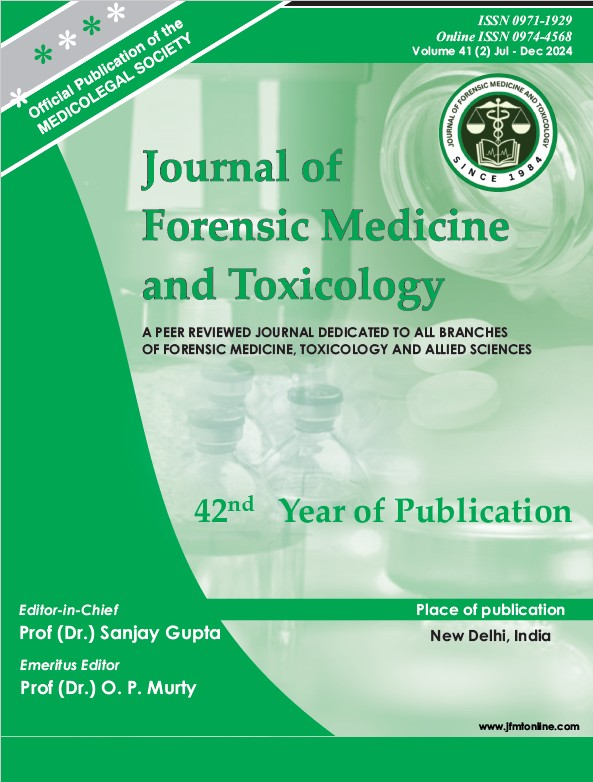Comparison of the completeness of ICD-10 Coding of medicolegal deaths before and after the implementation of ‘History taking’ Proforma- A two year study
DOI:
https://doi.org/10.48165/jfmt.2025.42.2.9Keywords:
ICD-10, History taking, External causesAbstract
ICD – 10, also known as the International Statistical Classification of Diseases, is the international standard for defining and reporting diseases, conditions and external causes that lead to the mortality or morbidity, thus aiding in comparison and sharing of health information using a standardized, common language. ICD is used by physicians, nurses, research ers, health information managers and coders, health information technology workers, policy makers, insures and patient organizations. Most countries use this system to report mortality data, which is a key indicator of health status. The pres ent study has been conducted as a one-year retrospective study and one year prospective study, giving emphasis on the history taking part of medicolegal postmortem examinations conducted in GMCH, Chandigarh. The aim of the study was to identify the defects in history taking by the use of Chapter XX of ICD-10, which focuses on the external causes of mortality.
Downloads
References
World Health Organization. (2015). International statistical classification of diseases and related health problems – 10th revision (Vol. 1, 5th ed., pp. 1218–1304). WHO Library Cataloguing-in-Publication Data.
L’Hours, A. C. P. (1990). The ICD-10 Classifications of Injuries and External Causes. Geneva: World Health Organization. Available at: https://www.cdc.gov/nchs/data/ice/ice95v1/C22.pdf. Accessed on: 10th Dec, 2024.
World Health Organization. (2018). ICD-11: Classifying disease to map the way we live and die. Available at: https://www.who.int/news-room/spotlight/international-classification-of-diseases. Accessed on: 10th Dec, 2024.
Rooney, C., Griffiths, C., & Cook, L. (2002). The implementation of ICD-10 for cause of death coding—some preliminary results from the bridge coding study. Health Statistics Quarterly.
Bugeja, L., Clapperton, A., Killian, J., Stephan, K., & Ozanne-Smith, J. (2010). Reliability of ICD-10 External Cause of Death Codes in the National Coroners Information System. Health Information Management Journal, 39, 16–26. Available at: https://www.researchgate.net/publication/47645104_Reliability_of_ICD-10_External_Cause_of_Death_Codes_in_the_National_Coroners_Information_System/citation/download. Accessed on: 10th Dec, 2024.
McKenzie, K., Fingerhut, L., Walker, S., Harrison, A., & Harrison, J. E. (2012, January). Classifying external causes of injury: History, current approaches, and future directions. Epidemiologic Reviews, 34(1), 4–16. Available at: https://academic.oup.com/epirev/article/34/1/4/492538. Accessed on: 12th Feb, 2025.
Patel, B., & Yadav, J. (2021). ICD classification of autopsies conducted for deaths due to trauma in Bhopal, Madhya Pradesh. International Journal of Toxicological and Pharmacological Research, 11(3), 58–64.
World Health Organization. WHO Family of International Classifications (WHO-FIC). Geneva: WHO. Available from: https://cdn.who.int/media/docs/default-source/classification/who-fic-network/who-fic-family-paper.pdf?sfvrsn=a34cef4b_3&download=true. Accessed on: 6th Jan, 2025.




